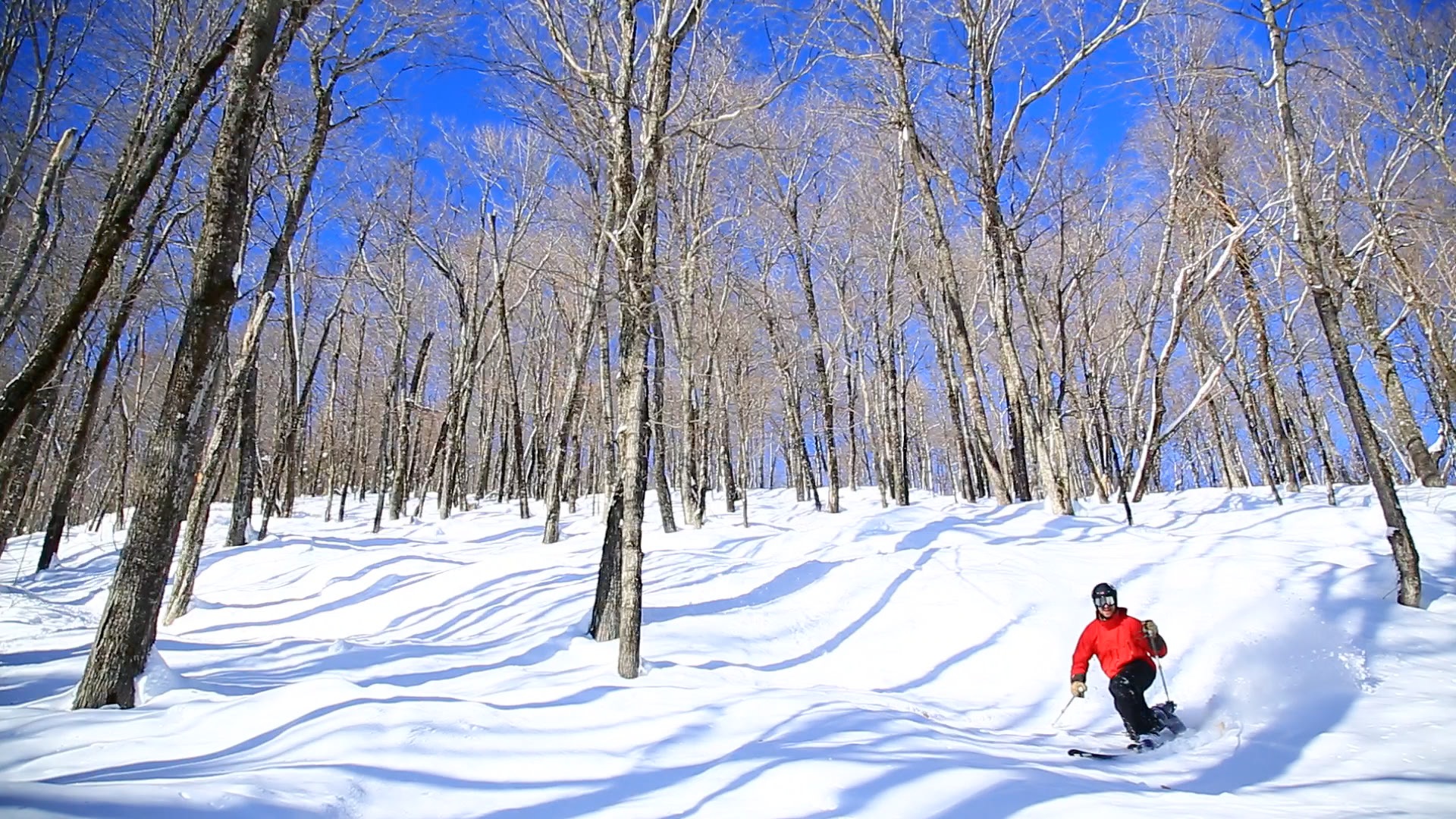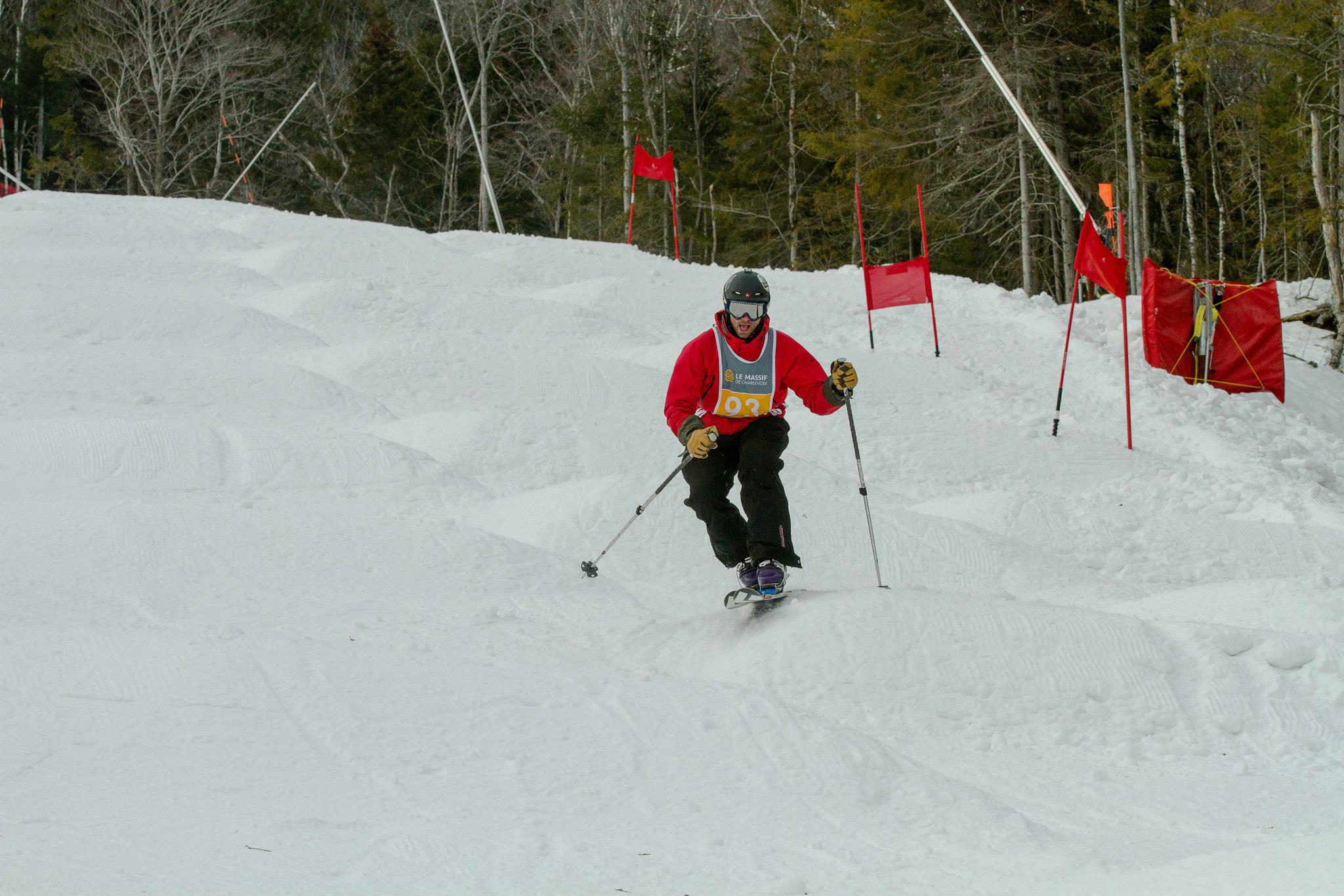Telemark skiing is a fluid a dynamic movement.
I often related to it as dancing down the mountain. I like the flow and the freedom freeheel telemark gives me. And it’s all about that feeling.
Different styles can be seen and two skiers can easily approach the same terrain differently. One big question remain: Should I go down all the way or should I stay high in my telemark stance ?
Above: high stance and low stance in moguls.
There’s no easy answer to that. It is generally said that a higher stance limits your efforts and gives you a quicker response should you lose balance. So telemark instructors have preached with a higher stance. Good reasoning. And that’s what I tend to do.
But a lower stance also have lots of advantages:
- it’s fun;
- it lowers your center of gravity, making balance easier;
- it enable you to stay in movement for a longer period during your turn. I call this dynamic balance. If you are moving, dancing, you can stay with the rhythm of the song more easily. The analogy relates to the terrain dictating the technique. We have to adapt to it. If, on the contrary, you pause and change rhythm constantly, making short movements, it will be much harder to stay balanced, especially if there is an unforseen obstacle that creates an unbalance. The slope is not constant, other people around you are not constant, the snow is not constant. Keeping your body in motion is one key to staying balanced and in control. Telemark skiing offers that freedom more than alpine skiing or snowboarding because of the equipment, because of the freeheel. Momentum is an advantage. Getting low sometimes gives you the extra motion you may need.
Getting low, staying high, both have advantages. There is no one way. I teach to stay as high as possible when you can and to get as low as possible when you need. Also, a common mistake is that people will try to stay high all the time and have never experienced to go low. You need both in your tool box.
Finally, telemark skiing is a lot about feeling. Stay up to save energy, respond quickly and get down in technical, unpredictable terrain.
And get some style for the show…
Oh by the way, the guy with the green pants is by far the fastest telemark skier I’ve ever seen in moguls 
What’s your approach? Leave us a comment below
Join Absolute Telemark












Low stance just looks cooler
I kinda agree !
Yes but with my Rottefella NTM freeride it’s hard to go down. Is it because it’s a new material or because of this kinf of fixation or because I am to old or because I am to light ?
thanks for answers.
I think that you can adjust the tension/resistance on your NTN bindings. If you back off the resistance then going low should be easier.
I just switched from 75mm to NTN – had a bit of Tele hiatus….love the NTN need more days on the mountain and also need to adjust the tension. Have no one around me to assist (no one is a telemarketer) live in SoCal not too many of us here. How do you adjust the tension (5’7″ 118lbs fairly aggressive skier )
BTW – low stance
Hello Bev, It depends on your binding.
Rotofella NTN as a white line on the cable. You have to align the line with your boot in the binding, going for the middle of the boot.
Outlaw, Meidjo, Lynx have diffrent adjustments too
Apes are walking next to the ground!
Evolution made up stand up!
One vote for the high stance!!
There is no magic here, when I want to look good I go low, when my legs are on fire exhausted I stay high. From there it is a run by run call. To be fair most people will call me a low telemarker however I started in leather boots on skinny skis where low gave you more torque so I have had to learn high as my gear has improved and my legs have gotten older.
I think it also depends on your build and body shape. I am 6’5″ and getting low with long levers creates a lot of torque in my legs. To stay compact and poised I actually need to ski mid to high stance. I have a good friend who is much shorter and compact in his build. He skis lower and it suits him. Having said that I generally go low at speed – long GS turns at full speed suit an aero stance. Plus, getting low in powder is fun – more face shots!
High skiers often look as if they are “telellel” or “paramark”, with rear knee tucked in behind front leg. Staying low is great in bumps and chopped up snow – just pushing the legs out to move snow and control speed. And other times just plain, good, exhilarating fun.
With Freedom bindings I can easily put my knee onto the ski. https://uploads.disquscdn.com/images/5f1eb29e76e01e49614f5e1cc22f09473018337133824f45d1992aab4cc754de.jpg
So, I’ve just finished a day on the slopes in Mayrhofen whilst the snow was falling heavily.

I’ve watched all the tutorials and did try staying more upright but I just feel unstable, I can’t seem to get my skis parallel and it just doesn’t feel right.
Going low on the other hand feels awesome. I can go at speed and carve well and my friends say it looks great. However my legs are now battered!
It is a case of grin and bare it as by the end of the week I’ll thighs of iron!!!
Go low like a pro!
I’m too much tall and “old” my legs aren’t so much powerful and rapid to stay down but i’ like to watch powerful skiers that do it ! But highest is more beautiful to see and give the impression that “all things” are under control .
I’m a high telemarker.
As I telemark with my Backcountry XC skis (Rossignol BC90), NNN bindings & no hard plastic boots, I tend to prefer to stay a wee bit more upright.
But, I like to get into a lower telemark stance while going down steeper hills.
Bon ski
As has been said, I get low for steep, deep, fast and stay more upright when I am cruising on easier terrain. I learned in leather boots, 210 skinny skis with lots of camber and 3-pin so it took me a while to feel more at ease upright. I think I always look cool no matter what (I’m tele’ing) and see staying up or down as a matter of function.
I am an advocate of the higher stance to save my legs; and keep my feet closer together for ability to make quicker, smoother lead changes. I also think it is safer with the knee not so exposed down low. Pads and the ski itself can only provide so much protection when off-piste.
Having learned on leather boots and I used to keep the stance tight and low. With the advent of modern boots and bindings, I go high and tight. Dropping to a long and low stance occassionally. Especially in deep snow.